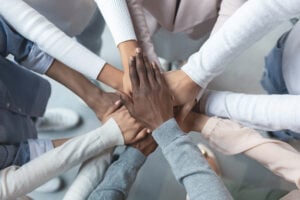
What now?
Pink pussy hats. Black squares on Instagram. Little safety pins on jackets. In the last few years, we’ve all seen these low-effort symbols of solidarity. But, like when a Black community is displaced by gentrifiers that erect Black Lives Matter signs on their new front yards, it is really hard to differentiate the “awareness raising” from “clout chasing” and virtue signaling. Which is why everyone who will be attending the ABA’s Equity Summit should be dedicated to pushing past the kumbaya jargon and asking what concrete changes will be made to foster diversity under attack. From the ABA Journal:
The ABA is once again hosting a fully virtual conference to educate lawyers, judges, law students and other legal professionals on crucial diversity, equity and inclusion issues and facilitate robust dialogue about how to address these issues.
The 2023 ABA Virtual Equity Summit, scheduled for Oct. 23 and 24 and sponsored by the ABA Diversity, Equity and Inclusion Advisory Council and ABA Continuing Legal Education, will offer several CLE programs and panel discussions, workshops and other events.
It is the second year for the summit, which was first host in September 2021 in response to ongoing national conversations about racism and inequality. An ABA press release is here.
Saying that the summit started in 2021 in response to ongoing national conversations makes it seem as if the conversations and associated consciousness raising is a new sociological development. To that, I’d like to share a video of a Black comic doing awareness raising about Black Americans being killed by police chokeholds. The video is from 1979:
We know that there are relatively few Black, Latino, Pacific-Islander, and Asian lawyers. Things are really hard for lawyers who are first-gen or who grew up in a broke household. We frequently complain about law schools whose idea of a mental health check-in is an email and pizza. What is going to be done about it?
The summit will discuss the importance of fostering diversity in the judiciary. My hope is that the discussion will be more than an abstract FYI — people should be leaving with a plan in hand. For example, a quarter of federal courts have only had white judges, how do we change that? Once the judges get on board, how do we make sure that they don’t pull an RBG and go decades with only one Black clerk? Is there a way to do this, legally speaking, with the recent attacks on affirmative action laid down by the Supreme Court?
October 24th’s “Disability Justice: Path Toward True Equity and Inclusion” discussion looks promising. Sure would be great if it led to the creation of a 10 Point Program that the ABA then uses as a standard for hold law schools accountable.
There’s been a lot of shining light on issues that you’d have to force your eyes closed to not see. We need less illuminating and more lever pulling. If these ideas and sentiments are as important as they’re being advertised, the ball needs to get rolling quickly. Ideally, before the Supreme Court makes it even harder to do so.
ABA’s Equity Summit Shines Light On DEI Issues In Legal Profession [ABA Journal]
 Chris Williams became a social media manager and assistant editor for Above the Law in June 2021. Prior to joining the staff, he moonlighted as a minor Memelord™ in the Facebook group Law School Memes for Edgy T14s. He endured Missouri long enough to graduate from Washington University in St. Louis School of Law. He is a former boatbuilder who cannot swim, a published author on critical race theory, philosophy, and humor, and has a love for cycling that occasionally annoys his peers. You can reach him by email at cwilliams@abovethelaw.com and by tweet at @WritesForRent.
Chris Williams became a social media manager and assistant editor for Above the Law in June 2021. Prior to joining the staff, he moonlighted as a minor Memelord™ in the Facebook group Law School Memes for Edgy T14s. He endured Missouri long enough to graduate from Washington University in St. Louis School of Law. He is a former boatbuilder who cannot swim, a published author on critical race theory, philosophy, and humor, and has a love for cycling that occasionally annoys his peers. You can reach him by email at cwilliams@abovethelaw.com and by tweet at @WritesForRent.

